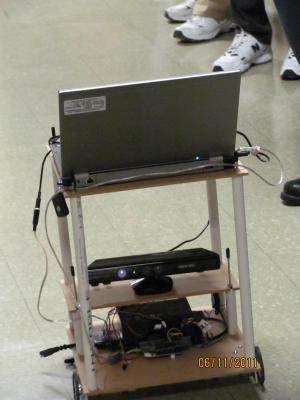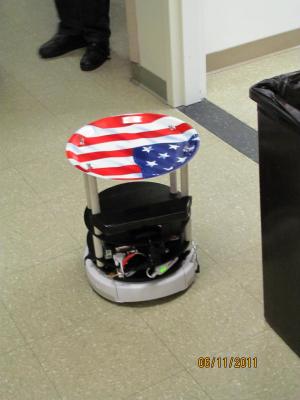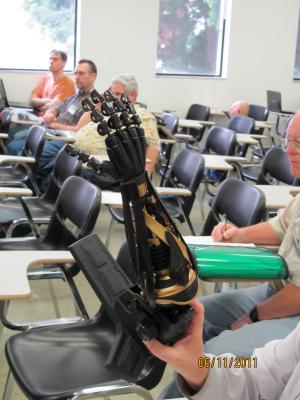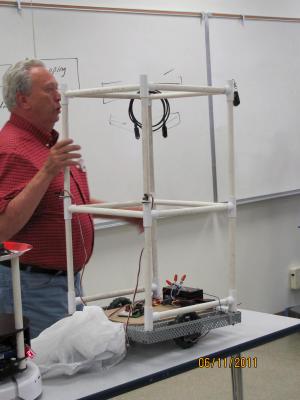June 11, 2011
Meeting Date:
Saturday, June 11, 2011
27 people at the meeting today.
Class:
Rainer taught the class at 11 am. Title = "2D Indoor Navivation using ROS"
The "Global Planner" provided with ROS uses Dijkstra's route planning algotithm.
Newer and probably better algorithms include A* (pronounced "A Star").
ROS makes a high-level plan for the navigation stack to follow, which includes a list of waypoints along the path to the goal.
There is Global Map of human-entered fixed walls and furniture and doorways - which ROS does not alter and it is used for localization - in combination with sensor data and a Monte Carlo method for eliminating incorrect robot positions on the map.
There is also a Local Map that is changing constantly and includes transient objects that are close to the robot.
Business Meeting:
We were not able to use the overhead digital projector today because both channel one and channel two now require a password. Previously only channel two required a password - so we had previously used channel one.
There were discussions about this and it was decided to take two actions - contact the university to ask for the password, and also determine if our treasury amount of $415 is sufficient for purchasing our own projector.
Two new people who attended todays meeting were Sergei Grichine who is a software developer, and Ricardo Duran who is interested in a beginners class on how to build a robot.
There were conversations about future classes and contests, results were:
| month | class | contest |
| July | Ron Rose on IR distance | no contest |
| August | Paul Ashley - VEX robot workshop |
VEX Sumo contest (large ring) Autonomous Sumo (small ring) |
| September | Martin Mason will host a ROS workshop | no contest |
Hallway Navigation Contest:
Two robots were ready and these were entered in the Hallway Navigation Contest. Martin Mason's robot and Rainer's robot.
The robots competed at level 7 (full length of the hallway in the presence of moving human obstacles). Martin Mason's robot won the contest.
Show and Tell:
Alex Brown gave a presentation on a problem his robot encounteres while traversing the hallway outside our meeting room,
the data collected and displayed in the form of a floor-plan on the robot's built-in-notebook computer - showed the hallway bent in the middle. Multiple repetitions of the hallway travel show the same unreasonable bent shape of the pathway. Careful consideration reveals that it's probably not due to drift of the robot's rate gyro. Possible candidate causes include:
- The hallway is wider in the middle than at either end.
- The laser scanner could have been upset by reflections from the mirror-finish metal panels of the pair of elevators in the middle of the hallway.
- The big metal elevators cause magnetic deviation, compared from magnetic heading along the two ends of the hallway.
Bob Huss talked about the new Boy Scout merit badge and showed us the merit badge book.
Thomas Messerschmidt demonstrated an assembled kit called Uncle Milton, which is a manually-operated toy arm and hand.
4 degrees of freedom. He also demonstrated a cell-phone-keyboard tester device.
Sergei Grichine talked about his large robot under development.
Paul Ashley demonstrated a low-cost-to-build robot base that seems to incorporate lots of white plastic pipe, has electric motors and wheels. www.robo-works.net
Bruce Weimer discussed his efforts to obtain a free but useful database of production rules and facts about a robot's world.
Starting with the 1960's General Problem Solver (an artificial intelligence program of the type called "production systems"), and continuing to the present versions such as ACT-R, Lisa written in Lisp, Jess written in Java, Clips written in C language, there are many versions available today.
Some data bases of facts and prodution rules include Open-Cyc and Cyc-L in Lisp. However they tend to include concepts that cannot be verified using the sensors on our robots.
Bruce would like to build upon his previous work in developing his "Leaf" emotion simulation for robots by using some combination of the above.






